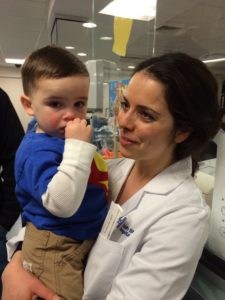
Cameron with Galina Lipton, MD
By the time Cameron Shearing arrived at the South Shore Hospital Emergency Department (ED) during a December snowstorm, he wasn’t breathing. He didn’t have much time. The two-year-old had aspirated a chocolate-covered pretzel, which sent tiny bits of material into his lungs.
The odds of a good outcome were not high. Pretzel is one of the worst foods to aspirate for two reasons: The small pieces can block multiple small airways, and the salt, which is very irritating, causes a lot of inflammation.
“Cameron was one of the sickest patients I ever cared for as an emergency physician. I did everything I could within my scope of practice, but he needed the tools and expertise of pediatric subspecialists,” recalls Galina Lipton, MD, from Boston Children’s Department of Emergency Medicine, who was staffing the South Shore Hospital emergency room that evening. Full story »

A clinician's-eye view of a patient with spinal muscular atrophy during a telemedicine visit.
The jury is still out on telemedicine. Proponents and many patients appreciate its ability to deliver virtual patient care and to extend the reach of experts beyond the brick-and-mortar setting of a hospital. But the real question about telemedicine is: Does it make it difference? Does is it improve care and if so, in what circumstances?
TeleCAPE, a small pilot project at Boston Children’s Hospital, inches the dial toward “yes” for some patients—in particular, home-ventilated patients.
Home-ventilated patients require an inordinate amount of health care resources for even minor conditions. Costs for a simple urinary tract or viral respiratory infection that might be managed without hospitalization can reach up to $83,000 because the child’s complex medical needs require ICU admission. Full story »
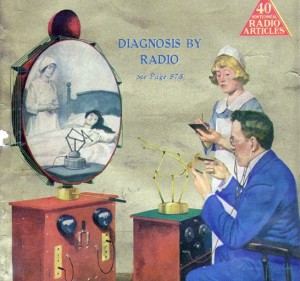
The TeleDactyl, as depicted on the cover of Science and Invention magazine in 1925.
Shawn Farrell, MBA, is Telemedicine and Telehealth Program Manager at Boston Children’s Hospital.
Back in the 1920s, when medicine was more an art than a science and doctors made home visits, a publishing and radio pioneer named Hugo Gernsback predicted the future of telehealth. As described on Smithsonian.com, he wrote of a device called the TeleDactyl: “a future instrument by which it will be possible for us to ‘feel at a distance’”—dactyl, from the Greek, meaning finger.
Since that time, the practice of medicine has changed dramatically. Our understanding of the human body has advanced beyond our wildest dreams, producing drugs, devices and procedures that have made hospitals a place for healing and curing. At the same time, home visits were abandoned in favor of the office visit, making doctors more efficient. Almost 100 years later, several converging forces are making the home visit popular again, increasing the likelihood of seeing Gernsback’s vision become a reality.
The rollout of the Affordable Care Act, which will add millions of new patients to the health care system, comes at the same time that we have a shortage of primary care doctors, specialists and other care providers. Full story »

(Diane Campbell Payne, used with permission)
Naomi Fried, PhD, is chief innovation officer at Boston Children’s Hospital. This post is adapted from her remarks at the Connected Health Symposium on October 24, 2013. She tweets @NaomiFried.
In the health care industry, we rely heavily on regulations to ensure the safety of our patients, procedures and drugs. New national health care regulations can even spur innovation in care delivery, but in the case of telehealth, they can be an impediment.
Telehealth, the remote delivery of care via computers, mobile devices, videoconferencing and other technologies, has great potential to improve the patient experience and reduce health care costs by removing the barriers of brick and mortar. At Boston Children’s Hospital, the Innovation Acceleration Program’s pilot telehealth programs have focused on both direct patient care and virtual clinician-to-clinician consultations.
Unfortunately, most states’ regulations are limiting providers’ ability to broadly offer telehealth services. Full story »
 Since our “trends” posts at the top of the year are among our most viewed, Vector took time out this summer to take an interim snapshot of pediatric medicine’s cutting edge. Here we present, in no particular order, our first five picks. Check back next Friday for Part 2. If you want more, there’s still time to register for our National Pediatric Innovation Summit + Awards (September 26-27). The posts will also appear as an article in the fall issue of Children’s Hospitals Today magazine.
Since our “trends” posts at the top of the year are among our most viewed, Vector took time out this summer to take an interim snapshot of pediatric medicine’s cutting edge. Here we present, in no particular order, our first five picks. Check back next Friday for Part 2. If you want more, there’s still time to register for our National Pediatric Innovation Summit + Awards (September 26-27). The posts will also appear as an article in the fall issue of Children’s Hospitals Today magazine.
1. Digital health apps 2.0
The electronic revolution in health care continues. According to recent surveys, more than 90 percent of physicians have smartphones and more than 60 percent are using tablet devices like iPads for professional purposes. Dr. Eric Topol and others think these digital tools are the future of medicine.
Mobile apps keep proliferating, adding more and more features: high-quality image capture, voice-to-text capabilities and gaming techniques to motivate adherence, as well as sensors that gather physiologic data, like glucose levels and heart rate. Consumers are tracking and sharing data themselves, saving time in the clinic and helping physicians monitor their symptoms. Through the much-hyped Google Glass, it won’t be long before doctors can seamlessly call up patient data, look up a drug dosage and get decision support during a clinical visit without using a hand-held device.
One limiting factor in this “Wild West” scenario is the FDA’s ability to keep up with digital advances from a regulatory standpoint. Full story »

(Flickr/Anonymous Account)
This post is third in a series on obesity. Read last week’s posts on food addiction and what it means to define obesity as a disease.
The goal of any community health intervention is for individuals to achieve daily lifestyle goals in a way that realistically takes into account their cultural backgrounds, neighborhoods, families and home lives. For overweight or obese adolescents, these intimate surroundings play a pivotal role in allowing healthful behaviors to take root.
Research teams at Boston Children’s Hospital and suburban affiliate Wareham Pediatrics are conducting a study that lets adolescents collaborate with their doctors online to improve their weight. Videoconferencing technology, provided by Boston Children’s Telehealth Program, brings services directly to subjects in their homes.
“We’re bringing high-quality interventions directly to kids in the community where they live and simultaneously learning about the community itself,” says Cara Ebbeling, PhD, associate director of the New Balance Foundation Obesity Prevention Center at Boston Children’s Hospital, and one of the leading researchers. “For example, we are looking at what grocery stores are located in the community and what opportunities exist for physical activity.” Full story »
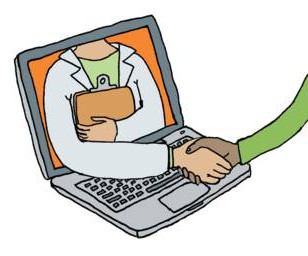
Teens with type 1 diabetes can download their blood glucose data and attend "virtual clinics" from home.
Most adolescents fight for the freedom to manage their own lives, especially when it comes to friends, curfews and hobbies. That excitement conspicuously slips away when they’re faced with managing something less glamorous—like diabetes.
Since diabetes is a chronic illness with potentially serious risks, it requires continuous management. But adolescents aren’t exactly lining up around the block for extra medical visits.
“Some adolescents forget to do things like take insulin or check their blood glucose level, and they could benefit from more frequent check-ins with their diabetes team,” says Erinn Rhodes, MD, MPH, director of the Type 2 Diabetes Program and Inpatient Diabetes Program at Boston Children’s Hospital. “But that’s not easy, especially if time is limited or if transportation is a challenge.”
So Rhodes has designed a study for adolescents 13 to 17 years old, to see if “televisits”—video conferences between teens and their diabetes care providers—can improve their diabetes while encouraging better self-management. Full story »
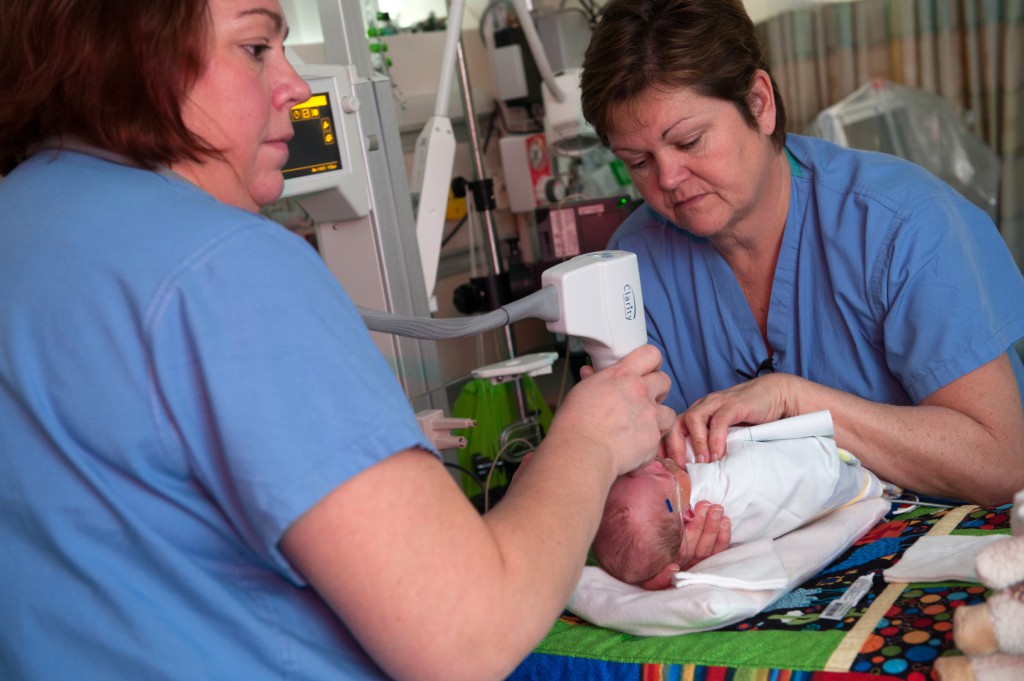
Gretchen Hamn (L) and Margie Young screen a premature infant for retinopathy of prematurity. (Photos: Katherine C. Cohen)
We’re in the Neonatal Intensive Care Unit at South Shore Hospital. Six tiny, swaddled preemies are ready to be examined, their eyes numbed and their pupils dilated with special drops.
Gretchen Hamn, NNP, and medical assistant Margie Young go from isolette to isolette. Young tends to the first baby and gently positions him for his exam. Hamn pulls over a cart and extends a kind of hose with a camera at the tip. This she places directly on each of the baby’s eyes, taking a digital video of his retinas. Full story »
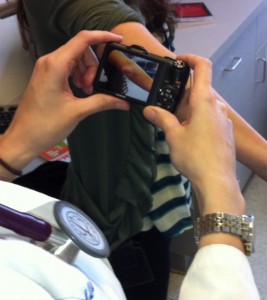
With a quick photograph by the pediatrician, a “mystery rash” can be diagnosed remotely.
“Hey, can you take a look at my patient’s rash?”
This question comes up on an almost-weekly basis at Martha Eliot Health Center, the community health center of Boston Children’s Hospital where I see children for primary care. While dermatologic conditions are common in pediatrics, and we, in the primary care setting, often know what to do about them, patients sometimes come in with rashes that don’t look like anything we’ve seen before. In these situations, we wish we could have a trained dermatologist just take a look, but the demand for new dermatology appointments at Boston Children’s is high and wait times for non-urgent clinic visits can be long.
From the dermatologists’ perspective, a large proportion of the patients in their clinic actually don’t actually need to be there—they have common conditions that can be managed in the primary care setting, in the patient’s medical home, in a much more convenient and cost-effective way. Full story »
Telemedicine has the potential to transform healthcare and lower costs. A new Massachusetts law requires insurers to pay for it—but with a potential loophole.
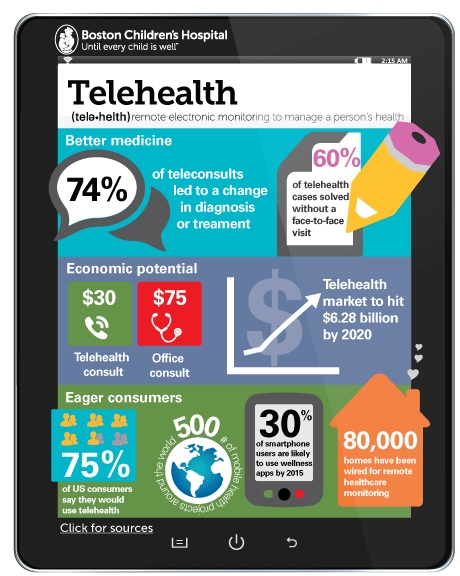
The mandate for broader access to health care in Massachusetts has brought millions of newly insured patients into the system. At the same time, the cost of health care in Massachusetts has continued to rise, and care access issues have emerged.
This past August, Massachusetts Governor Deval Patrick signed a new law that attempts to lower costs by shifting providers away from fee-for-service payment to alternative payment models (APMs) in which they incur more financial risk, and encouraging the development of accountable care organizations (ACOs).
One provision of this law requires insurers to pay providers for services delivered remotely via “telemedicine.” Full story »
















